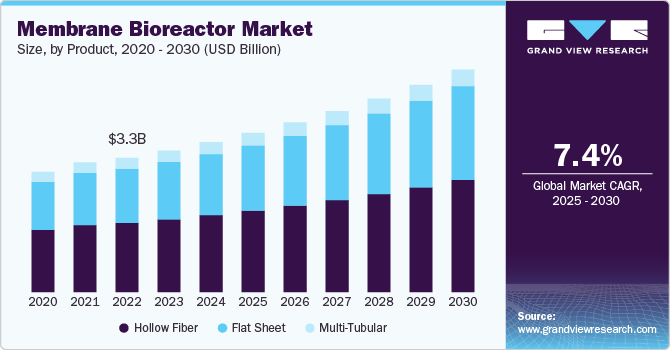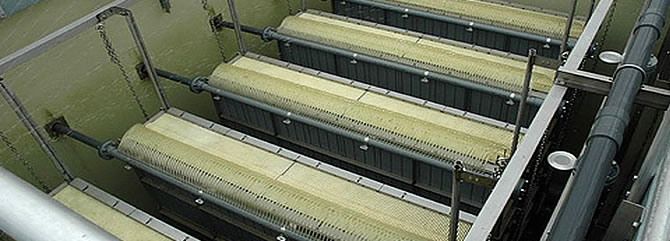How Membrane Bioreactor Contributes to the Reduction of Energy Consumption in Water Treatment
How Membrane Bioreactor Contributes to the Reduction of Energy Consumption in Water Treatment
Blog Article
Comprehending Membrane Bioreactors: The Future of Wastewater Therapy
Membrane bioreactors (MBRs) stand for a notable development in the area of wastewater treatment, integrating biological processes with advanced membrane filtration to improve effluent high quality. As worldwide water deficiency and rigorous regulative frameworks end up being progressively pressing problems, MBR technology offers a reliable action via its ability to minimize footprint and enhance source recovery.
What Are Membrane Layer Bioreactors?

The core parts of MBR systems include a bioreactor where microbial activity occurs and a membrane system that filters the combined alcohol. This double capability allows the simultaneous destruction of raw material and solid-liquid splitting up in a solitary action. MBRs can run in both immersed and outside setups, with immersed systems being much more typical because of their portable layout and operational performance.
The fostering of MBR innovation has actually obtained traction in numerous applications, varying from municipal wastewater treatment to industrial effluent monitoring. MBRs are specifically helpful in scenarios where room is strict or restricted effluent top quality criteria need to be met. By keeping a high focus of microbes within the bioreactor, MBRs boost the destruction of natural contaminants, thus yielding greater therapy efficiencies compared to traditional methods.
Key Advantages of MBR Innovation
The integration of biological therapy with membrane layer filtering in MBR systems provides various benefits that set it besides traditional wastewater treatment methods. Among the primary advantages is the boosted effluent quality. MBRs effectively get rid of suspended solids and microorganisms, achieving higher levels of purification that fulfill rigorous discharge requirements and facilitate water reuse applications.

One more considerable advantage is the decreased sludge manufacturing. MBR systems generate less excess sludge, leading to lower disposal costs and a decrease in environmental effect. The closed nature of the membrane system minimizes the risk of odor discharges and improves overall procedure control.
Lastly, MBRs are versatile and flexible, making them ideal for different wastewater kinds, consisting of commercial and metropolitan sources. The capability to integrate with innovative treatment innovations further boosts their performance, making MBRs an appealing option for the future of wastewater monitoring.
Obstacles and Limitations of MBRs
While MBR modern technology provides various advantages, it additionally encounters a number of challenges and restrictions that can impact its prevalent adoption. One significant obstacle is the high funding and why not try this out functional prices related to MBR systems. The preliminary investment for membrane layer products and the necessary infrastructure can be considerable, making it much less easily accessible for smaller municipalities or industries.
Furthermore, membrane fouling continues to be a critical issue that can decrease system efficiency and increase maintenance demands. Fouling happens when solids, raw material, or bacteria accumulate on the membrane layer surface, causing lowered permeability and calling for regular cleansing or replacement.
One more restriction involves the complexity of the innovation. MBR systems require competent employees for operation and maintenance, which can be an obstacle in areas with limited technical experience. The disposal of spent membranes offers ecological issues, as the products are typically not naturally degradable and can add to lose administration difficulties.
Finally, while MBRs can effectively deal with a broad array of wastewater, they might not appropriate for all applications, specifically those with high focus of fats, oils, and oils, necessitating further research study and innovation to address these limitations.
Applications of Membrane Bioreactors
In different sectors, membrane layer bioreactors (MBRs) have actually become a functional service for wastewater treatment (Membrane Bioreactor). Their applications cover local, industrial, and farming settings, showcasing their adaptability and performance in diverse settings. In local wastewater therapy plants, MBRs significantly boost effluent quality, enabling water reuse and lowering the ecological impact of released wastewater
Industrially, MBRs are used in food and beverage handling, fabric manufacturing, and pharmaceutical manufacturing, where they effectively deal with high-strength waste streams. Their ability to handle differing and rising and fall tons contaminant concentrations makes them especially important in these markets. Additionally, MBRs help with the elimination of pathogens, put on hold solids, and raw material, adding to conformity with stringent discharge regulations.
In agriculture, MBRs are significantly made use of for treating agricultural drainage and livestock wastewater, making it possible for the healing of nutrients for plant food manufacturing. They additionally help in the therapy of greywater for watering, advertising lasting water administration techniques.
The adaptability have a peek at these guys of MBRs is further shown by their combination with various other innovations, such as anaerobic digestion and advanced oxidation procedures, improving overall performance and resource healing in wastewater treatment systems.
The Future of Wastewater Therapy
Innovations in innovation and an expanding emphasis on sustainability are forming the future of wastewater treatment. Membrane layer bioreactors (MBRs) exemplify this change by integrating organic therapy procedures with membrane filtration, causing high-grade effluent ideal for reuse. The trend in the direction of circular economic climates is prompting facilities to embrace MBRs for their capability to recuperate resources, such as water and nutrients, from wastewater.
Innovations in membrane layer materials and arrangement are boosting the effectiveness and long life of MBR systems, lowering functional expenses and energy usage. Smart technology assimilation, including real-time monitoring and automated control systems, is more optimizing performance and enabling anticipating maintenance, hence lessening downtime.
In addition, societal expectations and regulatory pressures are pressing markets and municipalities to embrace even more lasting techniques. additional reading Membrane Bioreactor. The change towards decentralized wastewater treatment services is gaining traction, enabling local treatment that decreases transportation costs and power usage
Conclusion
Membrane layer bioreactors (MBRs) represent a transformative method to wastewater therapy, integrating organic procedures with innovative membrane layer innovation. The benefits of MBRs, consisting of improved effluent high quality, lowered spatial demands, and reduced sludge production, place them as a viable option in the middle of growing urbanization and stricter environmental policies. Regardless of existing challenges, the ongoing development in membrane layer materials and functional approaches guarantees to bolster the efficiency and adoption of MBRs, ensuring their essential duty in the future of sustainable wastewater monitoring.
Membrane layer bioreactors (MBRs) stand for a significant advancement in the area of wastewater treatment, integrating biological procedures with innovative membrane filtration to improve effluent high quality.Membrane bioreactors (MBRs) incorporate biological therapy processes with membrane layer filtering to effectively treat wastewater.The integration of organic treatment with membrane layer filtration in MBR systems offers various benefits that set it apart from typical wastewater treatment methods. Membrane bioreactors (MBRs) exemplify this change by integrating biological treatment procedures with membrane layer filtering, resulting in high-grade effluent suitable for reuse.Membrane layer bioreactors (MBRs) represent a transformative approach to wastewater therapy, incorporating biological processes with advanced membrane layer innovation.
Report this page